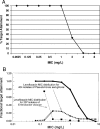Setting and revising antibacterial susceptibility breakpoints
- PMID: 17630331
- PMCID: PMC1932754
- DOI: 10.1128/CMR.00047-06
Setting and revising antibacterial susceptibility breakpoints
Abstract
Clinical microbiology laboratories need to communicate results of antibacterial susceptibility testing to prescribers. Sophisticated prescribers who are knowledgeable of the pharmacokinetics and pharmacodynamics of antibacterials may desire no more information than the MIC of the drug in question. However, most prescribers require interpretation of antibacterial susceptibility testing results. Breakpoints can assist in determining if an antibacterial is potentially useful in the treatment of a bacterial infection. Breakpoints should be set prior to an antibacterial being used clinically. Breakpoint setting requires integration of knowledge of the wild-type distribution of MICs, assessment of the pharmacokinetics/pharmacodynamics of the antibacterial, and study of the clinical outcome of infections when the antibacterial is used. It is mandatory that breakpoints be reviewed when antibacterial agents have been in clinical use for some time, particularly if mechanisms of bacterial resistance to the drug have been described. In general, greater amounts of information on the pharmacokinetics and pharmacodynamics of an antibacterial are available when breakpoints need to be revised. However, the opportunity to conduct randomized clinical studies of an antibacterial declines after the drug has been released commercially. Well-designed observational clinical studies are therefore necessary in order to provide reliable data to inform those reevaluating breakpoints. Breakpoint-setting organizations may also play a role in developing phenotypic tests for detection of resistance mechanisms, as this information may complement use of the breakpoint in some circumstances.
Figures




References
-
- Ambrose, P. G., and R. Quintiliani. 2000. Limitations of single point pharmacodynamic analysis. Pediatr. Infect. Dis. J. 19:769. - PubMed
-
- Ambrose, P. G., S. M. Bhavnani, C. M. Rubino, A. Louie, T. Gumbo, A. Forrest, and G. Drusano. 2007. Pharmacokinetics-pharmacodynamics of antimicrobial therapy: it's not just for mice anymore. Clin. Infect. Dis. 44:79-86. - PubMed
-
- Ambrose, P. G. 2005. Antimicrobial susceptibility breakpoints: PK-PD and susceptibility breakpoints. Treat. Respir. Med. 4(Suppl. 1):5-11. - PubMed
-
- Ambrose, P. G. 2006. Monte Carlo simulation in the evaluation of susceptibility breakpoints: predicting the future: insights from the Society of Infectious Diseases Pharmacists. Pharmacotherapy 26:129-134. - PubMed
Publication types
MeSH terms
Substances
LinkOut - more resources
Full Text Sources
Other Literature Sources
Medical

